INVESTIGATION: How Ondo community was left at the mercy of the sea after N6.2bn shore protection contract
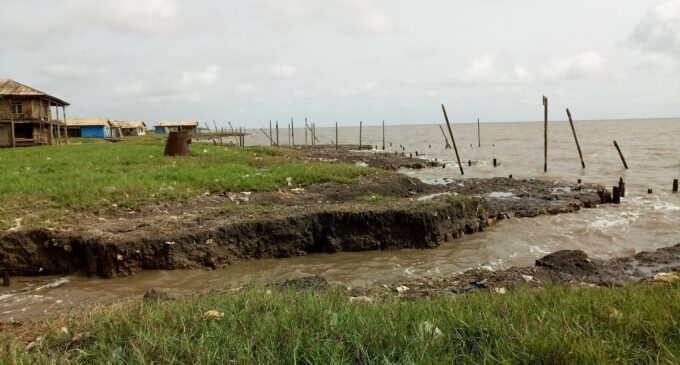
On December 15, 2004, four years after the establishment of the Niger Delta Development Commission (NDDC), the shore protection works for Ayetoro, a coastal community in Ilaje local government area of Ondo state, designed with a geotube technology which is the first of its kind in Africa, was awarded by the commission but later re-awarded in 2009 after the project was abandoned by the first contractor. 13 years after, the project lies fallow at the feet of the invading sea as the community struggles for survival against the storm. TAIWO ADEBULU writes.
The speedboat coughed to rest at the brink of the concrete wharf adjacent the community guest house. The rusty naked iron rods crisscrossing the weather-beaten wharf were drenched in the dripping rain. In the sight of unwelcoming rods staring at one’s scrotum ominously, disembarking becomes torturous and eternal like a camel passing through the eye of a needle. The wharf, according to Jaye Ikuyelorimi, the reporter’s guide, is just a fragment of projects which the Niger Delta Development Commission (NDDC) abandoned in the community.
AYETORO, THE HAPPY CITY
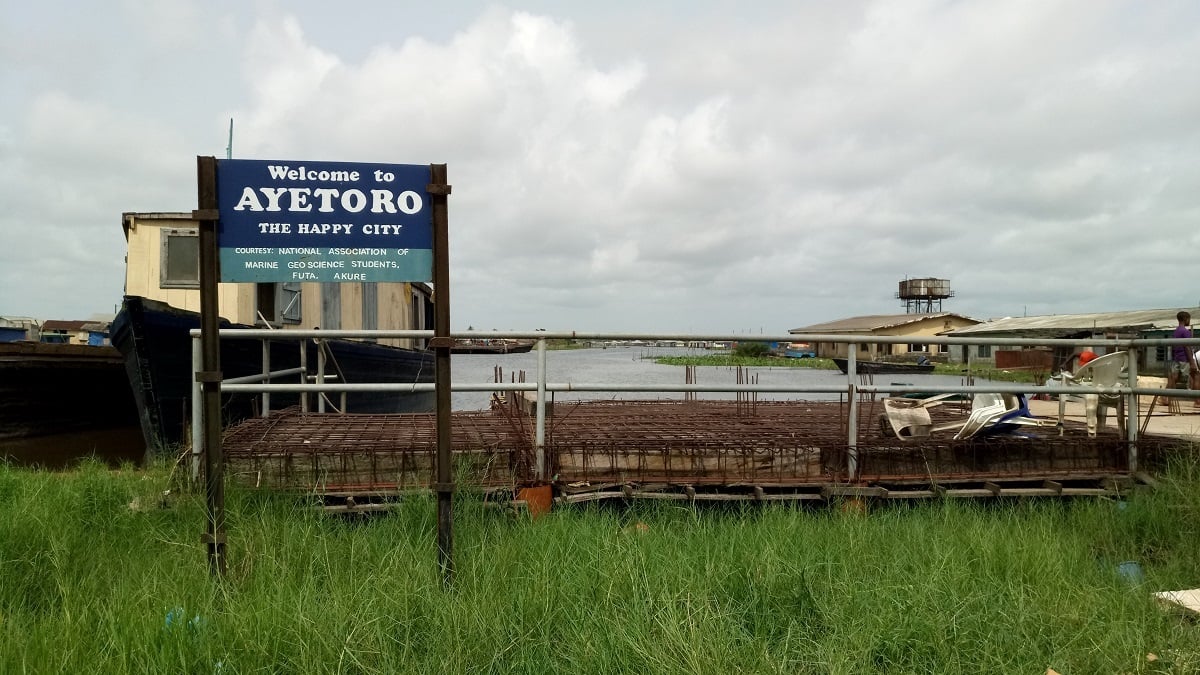
It could be happier, though
Tucked between the turbulent sea and a cobweb of soothing rivers, Ayetoro, a predominantly Christian community in the coastal belt of Ilaje local government area of Ondo was founded in 1947 by a group of Apostolic missionaries led by late Zaccheus Okenla “following a prophetic calling from God to move into a land near the sea to worship Him”. Hence, the Holy Apostles Church was established while its leaders function as the head of the church and the community. Aside practising theocracy, communism was also infused into their daily living. Virtually everything in community is collectively owned and controlled by the church. With about 10,000 residents, the streets of Ayetoro are well-laid out and houses strategically built opposite one another in horizontal lines – exuding a picturesque landscape.
According to Victor Akinluwa, the community public relations officer, Ayetoro became an autonomous kingdom after dragging the old Ilaje native authority to the supreme court in the 50s. The community won the case to stop the killing of twins, which became a tussle between the Christian community and its traditional neighbours. There and then, Ayetoro was issued a letter of incorporation by the then governor-general, Sir James Robertson who paid the community a visit. This brought a lot of development to Ayetoro as industries were built and advanced technologies were created such that it became a tourism hub that attracted eminent figures like the late Obafemi Awolowo, who came to study its appealing communal system.
Interestingly, Ayetoro has a powerhouse that had been supplying electricity to every home as far back as early 1950s. Its neatly paved streets and the industries: including a technical school, bakery, textile firm, shoemaking, ice making and soap factories, sawmill, six fishing trawlers and speedboat ferrying passengers from the community to Sapele, Delta state and Ebute-Meta in Lagos state – all owned and controlled by the community until the technical school was taken over by the state government and abandoned. Everyone contributes to one purse to fuel the plant. Interestingly, Ayetoro has never tasted the public supply of electricity from the national grid.
THE OIL CURSE
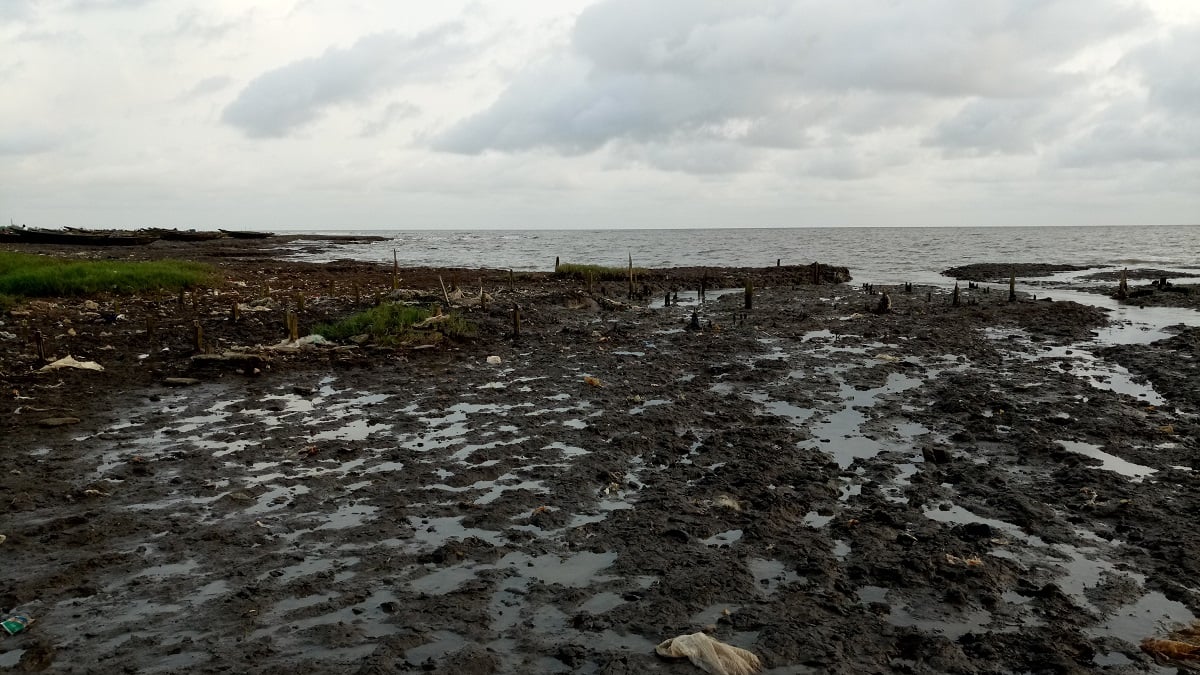
The first site of Happy City College, Ayetoro, completely washed away into the sea
As a delegate during the 2014 national confab, Olusola Ebiseni, a former chairman of Ilaje/ Ese-Odo local government and commissioner for environment in Ondo state, affirmed that oil was first discovered in Nigeria at Araromi seaside in 1908 and later at Ogogoro in Ilaje local government area in 1952, before it was discovered in commercial quantity at Oloibiri, Bayelsa state in 1956. With oil giants like Chevron Nigeria Limited, Shell and Texaco operating in the coastal area, the local government has placed Ondo state among the oil producing areas in Nigeria, which derives a large chunk of its revenue from oil. Credited with about fourteen oil wells, it contributes 12% of the country’s crude oil production and reserves, with about 3.5 billion barrels crude oil reserves.
However, the discovery of crude oil offshore has constituted a curse to the people than a blessing, while its age-long civilisation and communal efforts are fast eroding due to the exploration of the resources. From incessant oil spills endangering the aquatic life where the people earn their major source of livelihood from fishing to the perennial sea surge invading their homes, life has never been the same in Ayetoro.
NDDC TO THE RESCUE?
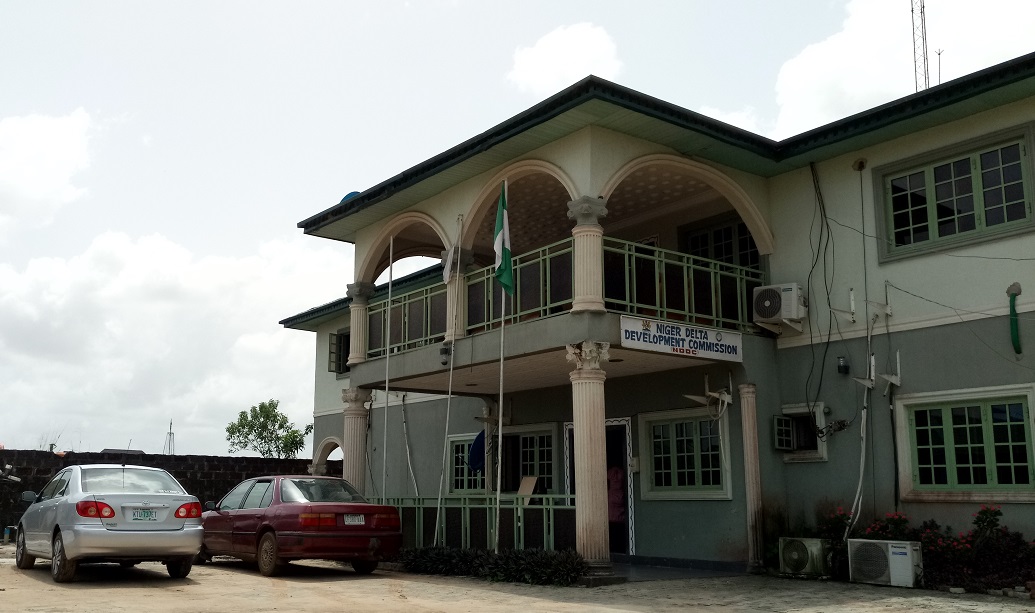
NDDC area office at Igbokoda
Following the ceaseless agitation and unrest in the Niger Delta areas over the environmental degradation and pollution of the region since 1950s, the Olusegun Obasanjo administration established the Niger Delta Development Commission (NDDC) in 2000. The agency was given the mandate to tackle the developmental needs of oil-rich states. Hence, the commission kicked off with a mission to facilitate the rapid, even and sustainable development of the Niger Delta into a region that is economically prosperous, socially stable, ecologically regenerative and politically peaceful. Funded with the oil derivation fund, NDDC was also asked to tackle ecological and environmental problems that arise from the exploration of oil mineral in the region through the execution of projects that would abate the challenges and touch the lives of the people in the nine member states.
According to the project data analysis on the commission’s Project Monitoring Information System (PMIS) portal, it has delivered 9,440 projects since 2002. However, during the 2014 budget defence of the commission in the senate, a former chairman of NDDC, Ewa Henshaw, said the Niger Delta Development Commission (NDDC) has a total number of 4,000 abandoned projects scattered across states of the oil-rich Niger Delta region. One of such projects is the shore protection works in Ayetoro.
SHORE PROTECTION WORK NEGLECTED
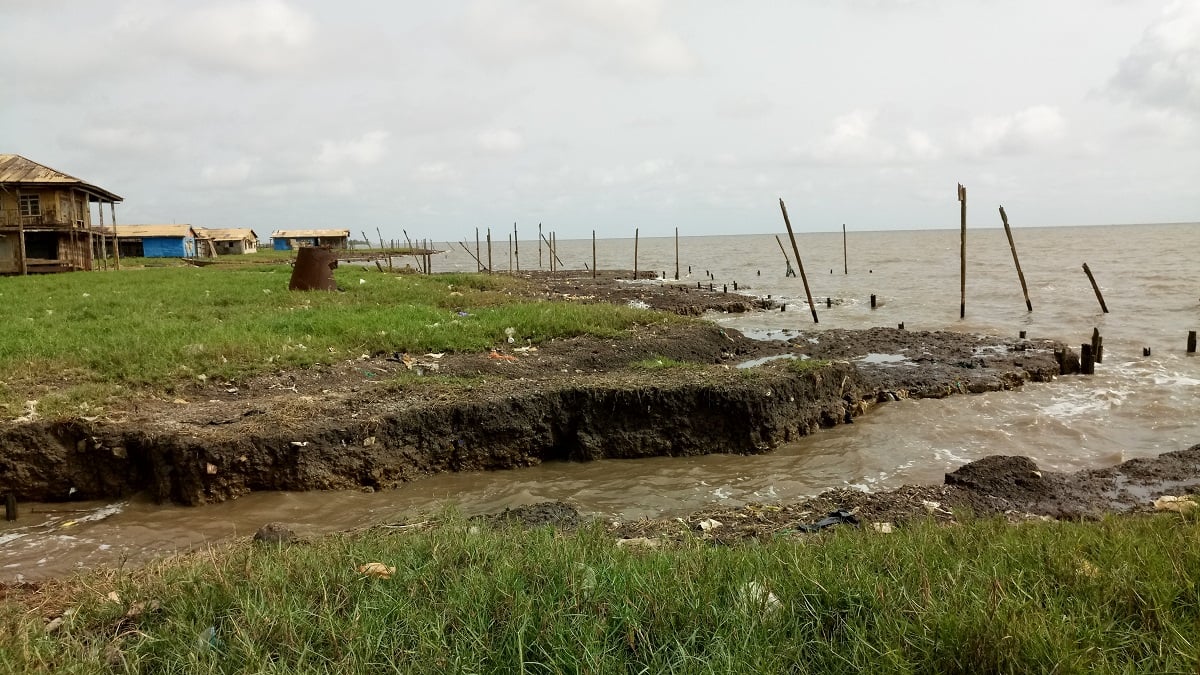
A sea shore in Ayetoro with broken pieces of houses that have been washed into the sea
“The sea surge started a long time ago when oil exploration and exploitation began on our coast. It happens every year and we have learnt to cope with it. Anytime the sea invades the community, it leaves our homes flooded and properties destroyed. We try to rebuild our homes and the city and continue with our lives. This is our ancestral land. We have nowhere to go,” Akinluwa said.
The shore protection works at Ayetoro with contract ID (NDDC/EDP/2/ONDO/PR/001) was awarded to Gallet Nigeria Limited on December 15, 2004, at the cost of 2.4 billion naira with twenty-five percent paid as mobilisation fee. The contract was, however, terminated by the commission four years after due to the lack of technical know-how and neglect of the project by the company. The project was, nevertheless, re-awarded to Dredging Atlantic Limited in 2009 to the tune of 6.2 billion naira, with 15% paid to the new contractor for mobilisation.
Investigations by this reporter at the oceanfront revealed a neglect of the project even after it was re-awarded. Except the abandoned heavy-duty equipment a few metres from the meteorological station, there was no staff of the company at the site or any work that signifies the beginning of a shore protection project.
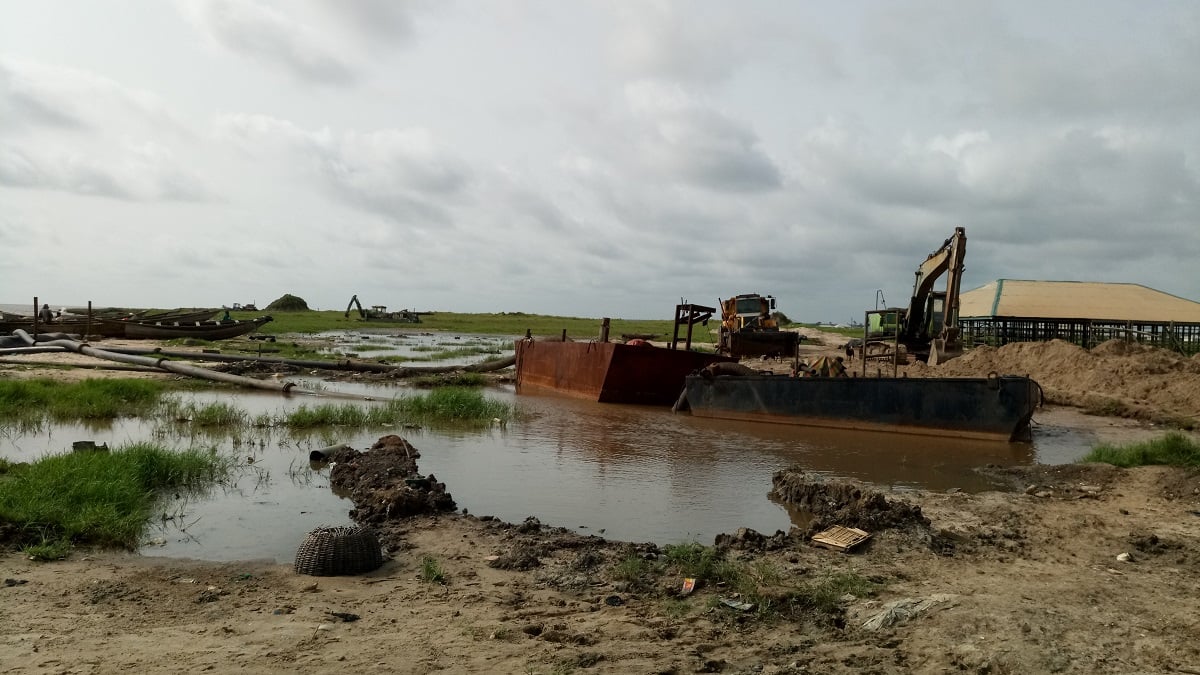
Abandoned equipment of Dredging Atlantics Nigeria Limited for the shore protection works
However, a sack upon which fish traders placed baskets of fresh crayfish was lying fallow at the base of the sea. According to Benson Atimise, who represented the community at a stakeholders meeting on the project in 2006, the perennial storm surge the community is battling with is as a result of global warming.
“As you can see, we have practically lost our shores. How do we get to the sea? We are predominantly fishermen and the sea is our farm. Our fishermen are relocating to Awoye community where there is a shore,” Benson said.
Aside the shore protection work, NDDC executed an extensive solar-powered streetlight project across the length and breadth of the community but only a few are currently working as others rot away due to the effect of the salty sea waves. Hence, residents still contribute money to operate the power house in order to lighten up the broad street. The water project executed by the commission didn’t extend beyond the location it was cited until the community contributed money to lay pipes across the streets for every home to benefit from it. Nevertheless, the water is not safe for drinking except for domestic use.
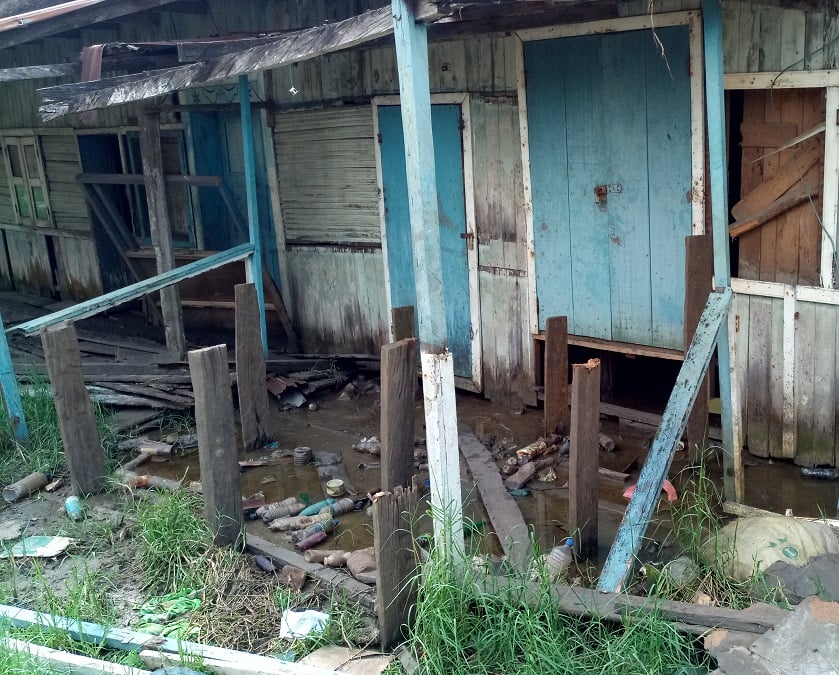
The remnants of a house affected by the sea storm
A document on NDDC website listed Dredging Atlantic Limited among the 391 prequalified contractors for NDDC projects from year 2010 – 2011. In an interview with the company’s public relations officer, Sola Oyinloye, he insisted that the project has not been abandoned.
“After we were awarded the project in 2009, we inherited the asset and liability of the first company that was awarded the project and could not even mobilise on site after being paid twenty-five percent mobilisation fee,” he said.
“So far, we have only been paid 1.1 billion naira out of the 6.2 billion project value. However, we couldn’t start work until 2013 because we had backlog of compensations coupled with the enormous challenge of sand search. It has been a serious problem. The project was designed such that we were meant to get sand offshore but there was none. Now, we have to get sand from Aboto which is 21 Kilometre from Ayetoro. We employed some members of Ayetoro as community liaison officers and we were paying them even while they were not working.
“Sometime ago, some members of the community tore the geotube with knives because they were not paid certain money. As we speak, the youths demanding for Christmas package have stopped us from working.”
When asked to put in percentage the status of the project towards completion and when it is expected to be complete, he said, “I can say we have done 40 percent of the job but I cannot say when the project will be completed due to the difficult terrain and logistics. Moreover, it’s a seasonal project.”
At the second national council on Niger Delta organised by the ministry of Niger Delta in Igbokoda, a community in the local government, with the theme Fast-Tracking the Development and Peace in Niger Delta Region, the Ondo state governor, Rotimi Akeredolu was reported to have lamented the gross infrastructural deficit in the area.
“This region presents a cruel paradox; the entire country depends on it almost entirely for sustenance. It, however, lacks evidence of development depicting its status as the proverbial goose that lays the golden egg,” the governor reportedly said.
‘CONTRACTORS BIGGER THAN NDDC’
On a sunny afternoon, this reporter visited the area office of the Niger Delta Development Commission (NDDC) in Igbokoda but was barred from entering the office by the fierce-looking security guard at the gate. While the reporter asked to see the officials of the commission, he said none of them was available and that the reporter should come back the following week. When a top official of the commission was called on phone, he said he wasn’t authorised to speak on the matter. After much persistence, he spoke on condition of anonymity.
He began: “I’m an indigene of Ilaje local government. If I tell you that I’m happy with what is happening, I’m deceiving you. That project is more or less an abandoned project. If the contractor is the one delaying it, we have every reason to call the contractor and see whether this project is even viable or not.
“I don’t even think the contractor that was given the job has the capacity to do it. The Ayetoro shore protection project was meant to be a test case and if it works, it will extend to other communities along the coast. But some of these contractors are bigger than NDDC.”
In an interview, Benson Enikuemehin, a former NDDC commissioner in the state, said the reason the project has been stagnant is due to the challenge in getting sand and lack of cooperation from the community members.
“The contractor had to go miles to get sand which wasn’t part of the deal but our people were not cooperating,” he said.
“The people must appreciate that citing government projects in their community is not an opportunity to make money. The community brought bogus claims to get undue compensations. At a time, they petitioned the Economic and Financial Crimes Commission (EFCC) around 2011 or so. The contractor was summoned. At the end, EFCC realised that the amount the work was awarded could not sustain it and concluded that the job shouldn’t be done lesser than 13 billion naira and they recommended an upward review of the project, but NDDC said they couldn’t afford it.
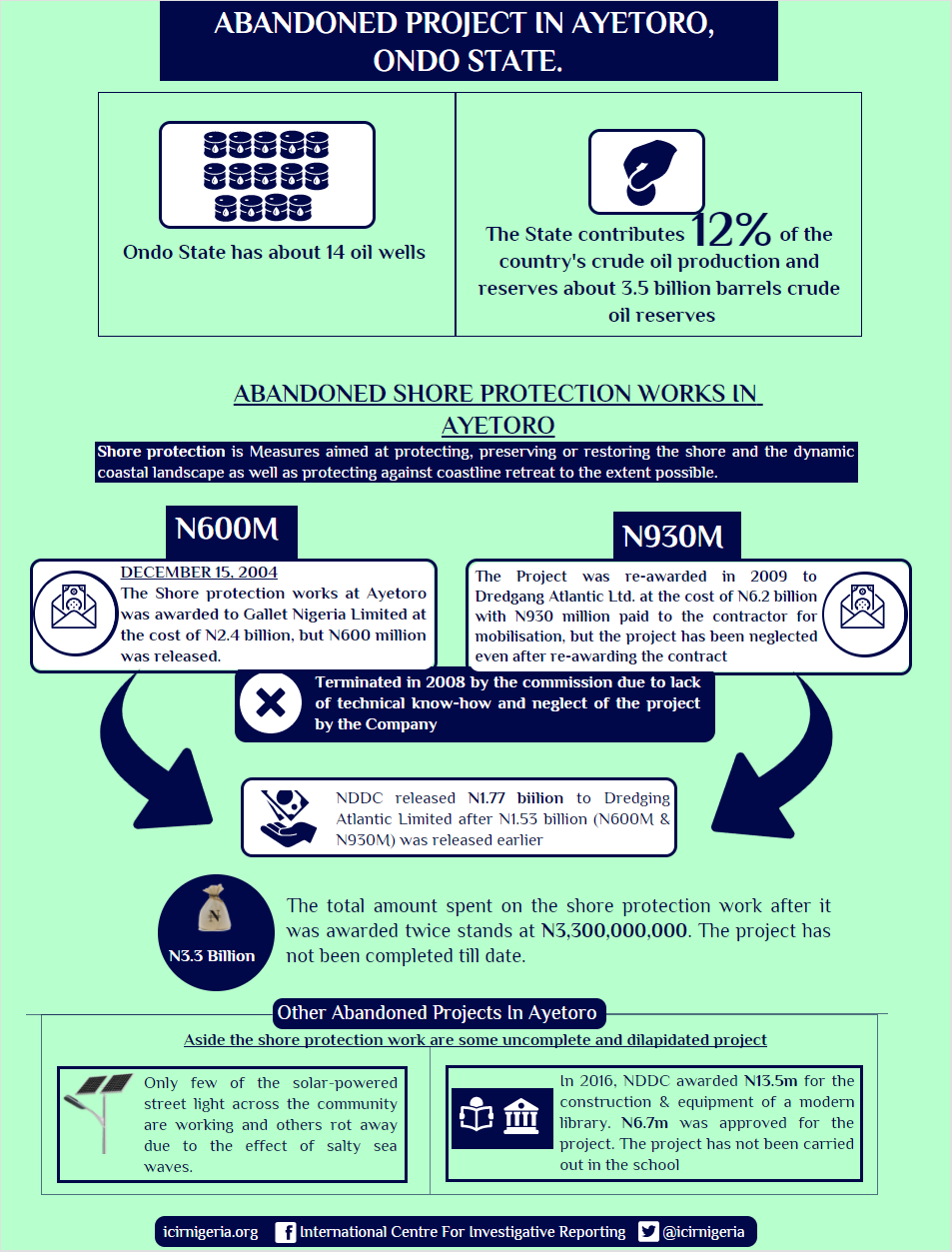
Ayetoro- Abandoned shore protection works
“The community should be ready to cooperate and make life less miserable for the contractor.”
While speaking with Emmanuel Audu-Ohwavborua, director, project monitoring and supervision directorate at the NDDC headquarters in Port-Harcourt, Rivers state, he said the project is ongoing although it has spanned about eight years.
“The project looks seemingly abandoned because there was no sand available to do the project and that gives the impression that it has been abandoned,” he said.
“But we’ve been working to find a way out by getting sand 25 kilometres away from the project site. When the canoes travelling with the sand pass through some communities that do not support the project, the youths sink the canoes.
“We are in constant touch with the contractor and we’ve been having meetings with him. What we are planning to do is to review the project and do it in bits. We’ll reduce the shoreline to be protected and that is because we’ve been working on protecting the whole shoreline of about 2 kilometres or thereabouts and we are not succeeding. The first phase will be to protect 700 metres of the shoreline and the remaining 900 metres will be redesigned as phase two. The process of the review is ongoing.”
BURIED IN THE DEEP SEA
Year-in, year out, the Atlantic Ocean overruns Ayetoro like bloodthirsty insurgents battering homes and lives. On sighting the invading threat, victims jump out of the window into the raging waves towering above their homes and swim with the tide to a safe spot. Displaced, they find safe refuge in the homes of community members who are ever willing to accommodate their very own. When the storm subsides, it leaves a trail of devastation, trajectory of misery and floods of sorrow. Hence, life in the community is brought to a standstill.
On February 2017, the incursion lasted for four days but resumed in mid-July occupying the whole community for a month. Residents were confined to their homes, schools closed and economic activities came to a dead end as more houses were buried in the deep sea. Moreover, it claimed the life of a little girl. Her bereaved mother, Olawunmi Iwametan, an apprentice, was inconsolable. Yet, she resigned herself to her fate.
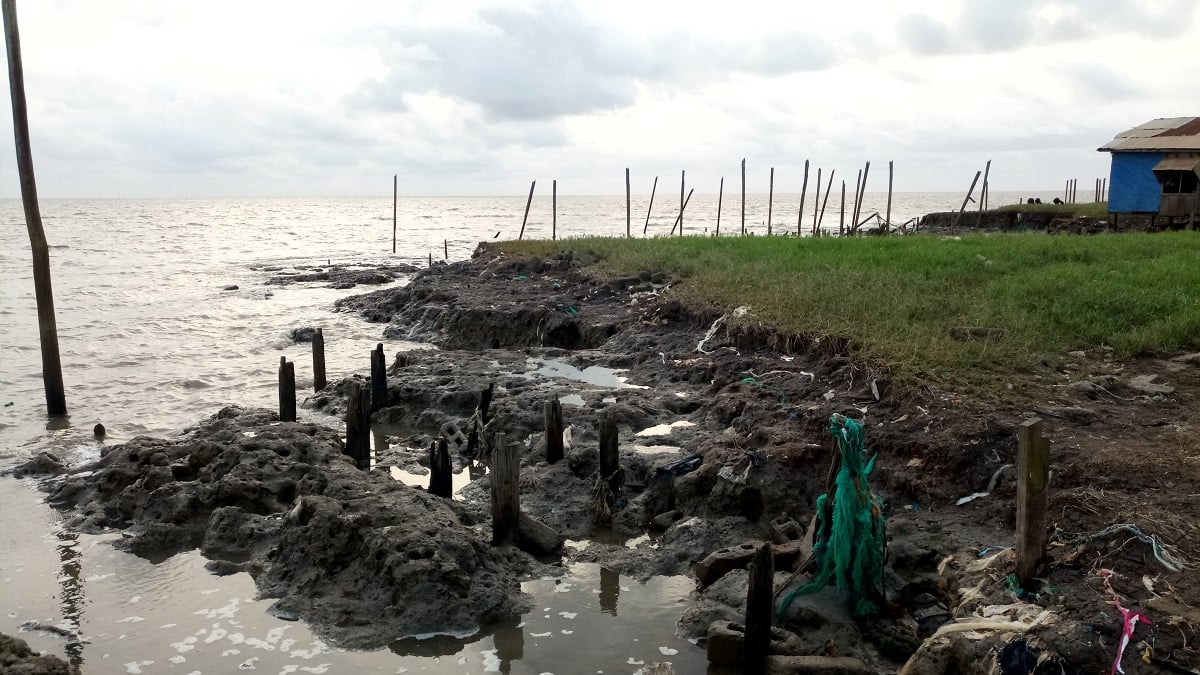
Fragments of broken houses that have been destroyed and pulled into the sea
Oluwanbe Aladetan, a 30-year-old fisherman, recounted how his family lost their home to the Tsunami that wreaked havoc on the city early in the year.
“We were sleeping at home in the night when we heard the sound of the sea charging at our home. We quickly woke everyone up and we all started jumping into the water from the window when the house was giving in to the sea,” he sad.
“Within a twinkle of an eye, our house collapsed before our very eyes. All our properties were destroyed. We couldn’t save anything. We became stranded and squatted with community members who were less affected by the siege. My wife, my three children and I are currently squatting with a friend. It hasn’t been easy staying in other people’s home. When my father couldn’t bear the losses, he left the community for Calabar because he had no house to live in again.”
The community youth leader, Ajinde Iretolu, expressed his displeasure over the frequent displacement of community members every time the storm strikes.
“We live at the mercy of the sea. It has claimed more than 500 metres of our land. It’s reducing the community landmass and we keep moving upland. The population is growing, while the land is shrinking,” he said.
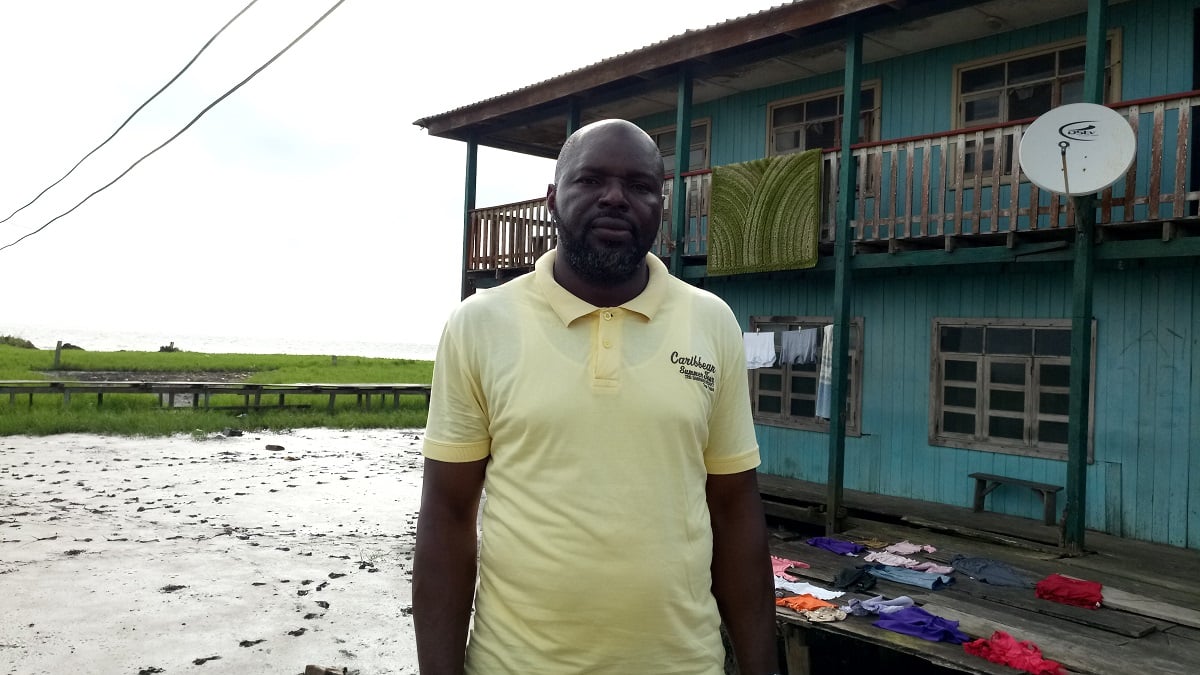
The community youth president, Ajinde Iretolu
When the project was abandoned by the first contractor, we complained and it was re-awarded to Dredging Atlantic Nigeria. Yet, nothing has been done. Let the government come to our rescue. The community-owned textile industry, shoemaking and sawmill factories have wound up due to this calamity befalling us. We just revived our bakery because we have to survive. Let the government come to our rescue.”
WE WON’T PERISH IN THE SEA
On a visit to the only public secondary school, Happy City College, Ayetoro, the original building have been washed away and submerged in the ocean. Consequently, a new structure was constructed, which has also been subjected to terrible battering by the sea. The school has, however, started constructing the third structure – a block of classrooms – behind the second structure. The school playing ground has also been immersed in water.
In an interview with Oladele Adeyemi, principal of Happy City College, the sea encroachment is seriously affecting pupils’ learning.
“When it happens during school hours, learning stops. The children will run helter-skelter to save their books. The sea will deposit mud into all those classrooms, including my office,” he said.
“It takes about three or four days before it recedes and we wash our classrooms to continue learning. If it happens when we are on holiday, it spoils our books and other school properties. Moreover, the NDDC two-classroom science laboratory building project in my school has been abandoned without completion for the past five years.”
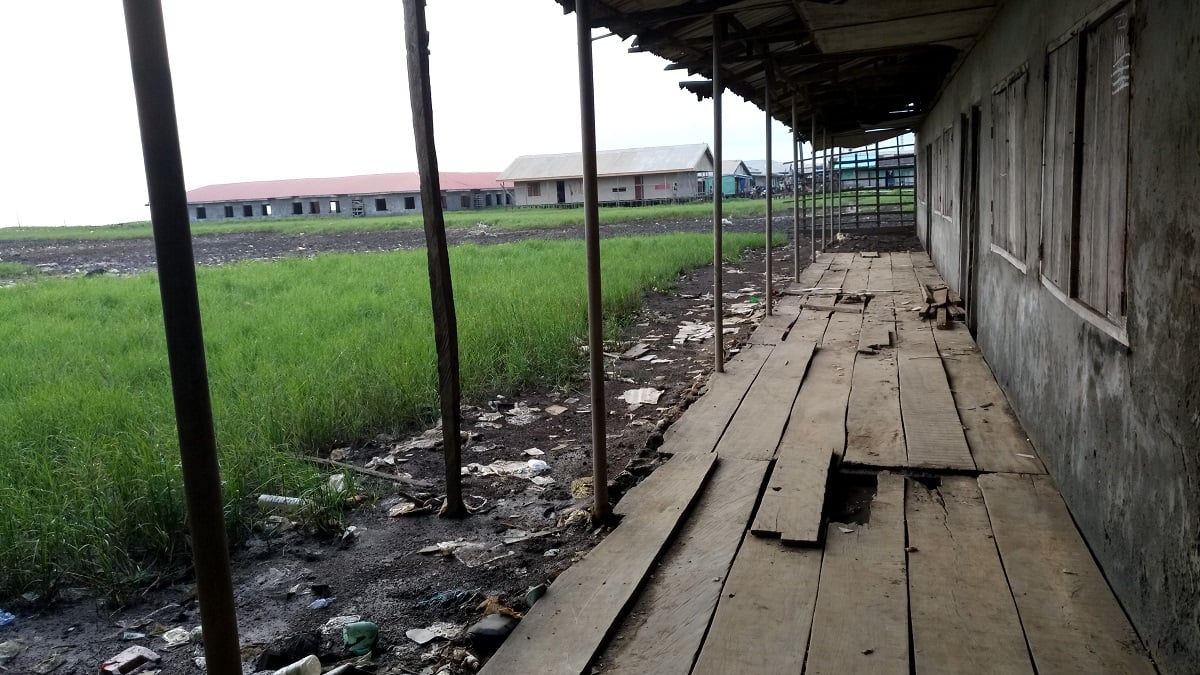
The current building of Happy City College, Ayetoro, being battered by the sea
Remarkably, the NDDC 2016 appropriation act approved a sum of 13.5 million naira for the construction and equipment of a modern library at Happy City College in 2015, while 6.7 million naira was approved in 2016, yet there was no such project in the school environment.
“Sometimes, it comes like a thief in the night,” Victor quipped. “Everyone has to stay awake to save their children and a few valuables they can hold. We are just lucky to be natural swimmers. Some years ago, when you are sent on an errand to the shore, it will take a long walk to get there.
“Now, it’s kissing our houses. We used to have an improvised mini-stadium but it has been washed away into the sea. At a time, they said they wanted to build another city for us far away from the sea but we insisted that if they must do that, they have to relocate the sea along with us because that is our source of livelihood.”
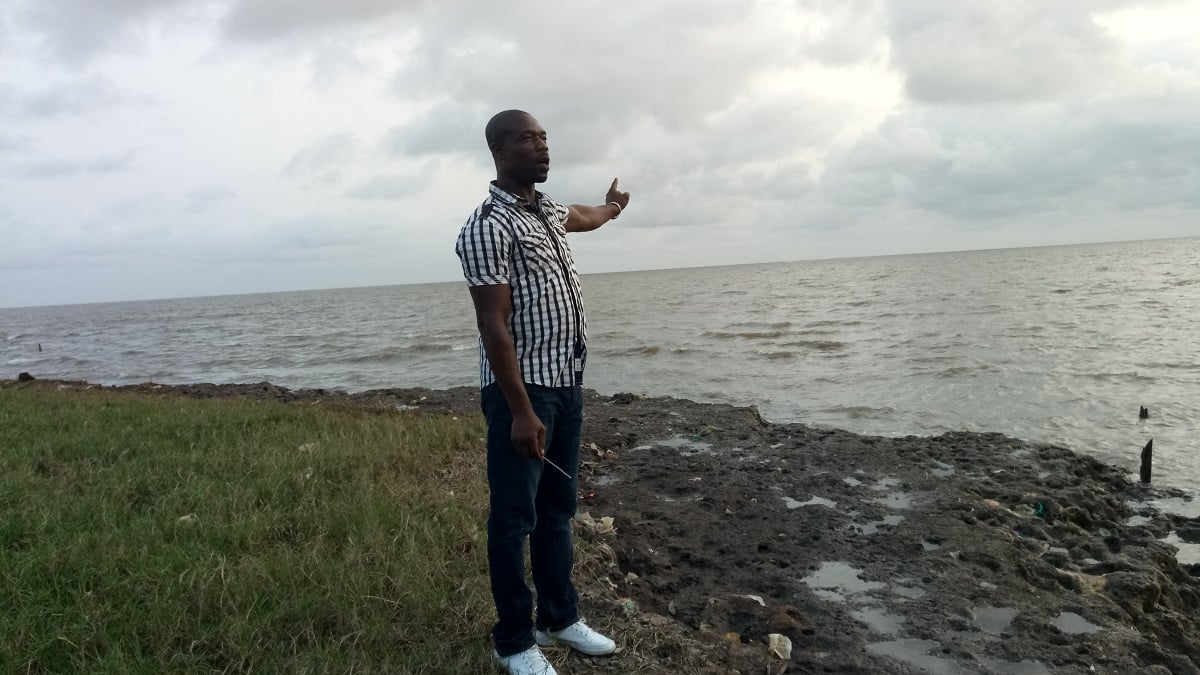
Ojo Olisa, a fisherman, pointing to the location in the sea where his father’s house was buried
For 42-year-old fisherman, Ojo Olisa, the sea storm is just like the biblical red sea which Moses led the people of Israel through against the invading Egyptians. With this conviction, he believed that the people of Ayetoro will overcome their challenges. Ojo, while pointing to a location in the ocean where his birthplace was built before it was consumed by the sea storm in 2008, gave a vivid account of what happened that fateful night.
“Our house had fifteen rooms. My wife woke up in the dead of the night after she noticed the sign that the storm was coming. She quickly moved our children out that night and came back for me, but I didn’t listen to her because it didn’t look as though it was going to be serious,” he said.
“My father also left immediately. Around 3am, the surge came suddenly and hit the house. It threw me out and I released myself to the wave until it pushed me upfront. I swam out. In the morning, our house was nowhere to be found. My father and I with my children had to stay with a friend. Shortly after, my father died.
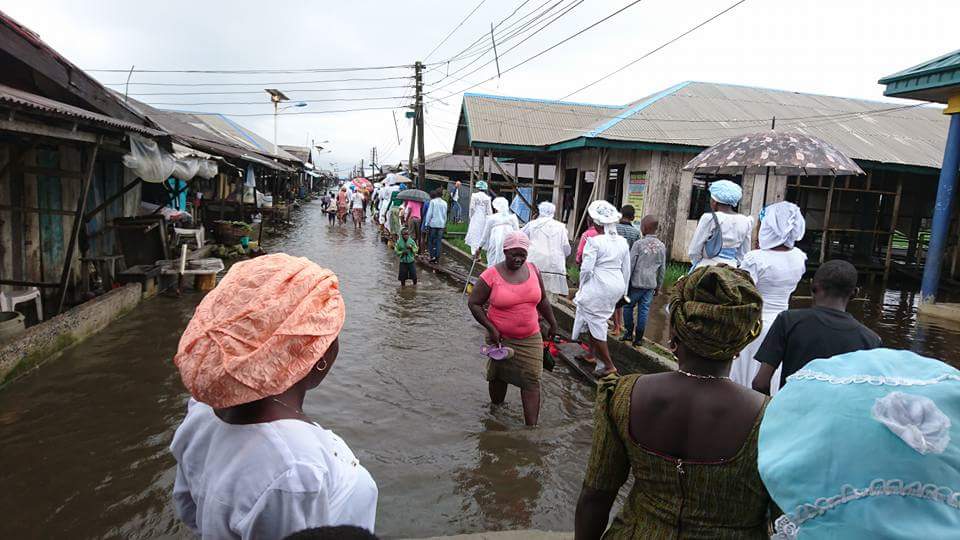
Aftermath of a sea surge with Ayetoto flooded
“The only reason why we cannot leave here despite the life-threatening challenges from the sea is because of the divine commission that brought our fathers here. We have a strong faith in the calling of our fathers. They never received a prophesy that we’ll perish in the sea. So, we cannot leave. It’s our ancestral land. God has called us here to worship him. For every decision we make, we consult him and follow his voice. Without the divine voice, we cannot move.”
THE NETHERLAND MODEL
While representing Ilaje/Ese-Odo constituency at the house of representatives in the 6th national assembly, Agboola Ajayi, incumbent deputy governor of Ondo state who was then the chairman, house committee on Niger Delta, was said to be displeased with the way the shore protection works in Ayetoro was being handled.
Hence, he embarked on a trip to The Netherlands in north-western Europe with two representatives of Ayetoro — Eniola Akingboye and Frederick Alebiosu, now deceased, for a comparative study of how the country was able to reclaim its land from the ocean through advanced technologies like the geotube.
The Netherland, like Ayetoro and most coastal communities in Ilaje local government area, is low-lying, flat and dominated by water features with about 50% of its land exceeding just one metre above sea level. Its total area of 41,850 square kilometres consists mostly of reclaimed land from the sea. Thus, people tout that God created the world, but the Dutch created the Netherlands.
“Yes, we visited the Netherlands in 2009 with Hon. Agboola Ajayi,” Akingboye confirmed to this reporter in a telephone conversation.
“We followed him to study how the Dutch were able to reclaim most of their lands from the sea and how the Geotube works for them. We were conducted round facilities, shores and shown video clips. When we got back to the country, we wrote our report. Hon. Agboola said he was going to forward it to the house. In fact, he recommended a geosynthetics company from the Netherlands to take up the project. Because of the politics associated with the contracting process, the project was not given to the company.
“Three months ago, the local government chairman said we should write another letter which he said he was going to submit to the governor. We haven’t got a reply. ”
Afolabi Aboyewa, a former chairman of Ondo State Civil Service Commission and the head of Zion Ikorigho community whose land reclamation and sand filling project had been abandoned since 2012 when it was awarded by NDDC, wrote a proposal on the need to adopt the Netherland development pattern in the local government because they share environmental similarities.
A copy of the proposal, which was obtained by this reporter, was distributed to political and traditional leaders and governmental agencies operating in the local government, but nothing has been said of it till date.
BEFORE NIGER DELTANS BECOME ENVIRONMENTAL REFUGEES
Johnson Atimise, secretary-general, Supreme Council of Elders in Ayetoro, said the community had written a series of letters to the State Emergency Management Agency, yet their plight has not been addressed.
“The sea level keeps rising and we fear the unknown,” he lamented. The septuagenarian’s fear is shared by all members of the community, in that they might sleep one day and wake up the following day with the community entombed under water,” he said.
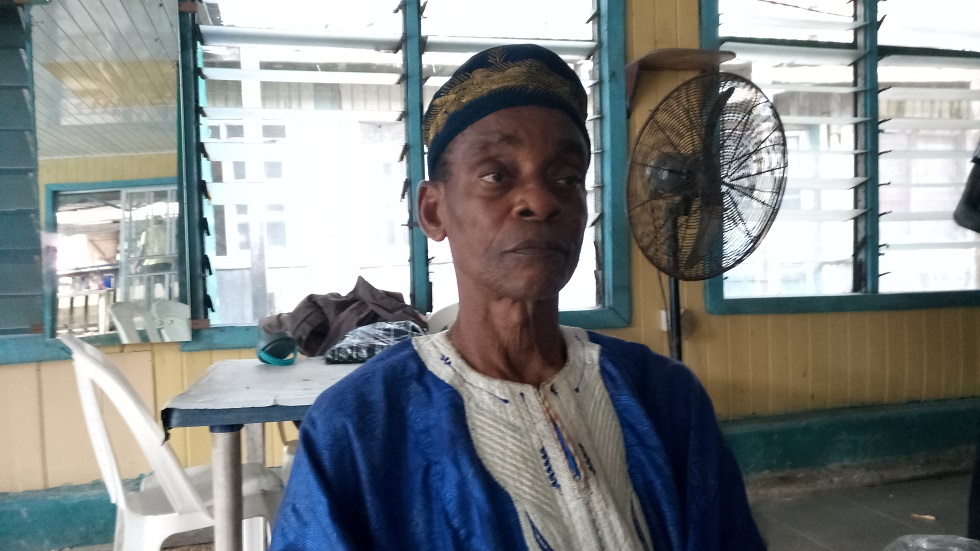
Apostle Johnson: “The sea level keeps rising and we fear the unknown,”
However, during the 2014 World Environment Day in Abuja, Laurentia Mallam, former minister of environment, warned that about 32 million Nigerians living on the coastlines in the Niger Delta might be displaced due to rise in the sea level.
She reportedly stated that with an accelerated sea level rise of 0.5 metres, 35 percent of the Niger Delta land mass would be lost, adding that with accelerated sea level rise of 1.0 metres, 75 percent of the Niger Delta would be gone under water.
In a 2007 assessment report by the Intergovernmental Panel on Climate Change (IPCC), global sea levels rose to an average rate of 1.8 millimetres a year from 1961 to 2003, with the fastest growth occurring between 1993 and 2003, an average rate of 3.1 millimetres a year. In one of the regional studies conducted by the organisation, the most vulnerable areas are concentrated along the west coast of Africa, Southern coast of Mediterranean and South Asia while 70 percent of the Nigerian coast would be inundated by a 1-metre rise, affecting more than 2.7 million hectares and pushing some beaches 3 kilometres inland.
ENDLESS PROMISES
Ayowole Aworetan, chairman of Ilaje local government area, said he was aware of the environmental challenges that have caused untold hardship on the people of Ayetoro.
“I have visited the place more than five times. I took pictures of the sea shore and the letter written by Mr. Eniola Akingboye to the governor to show him what the people are passing through. The governor has started taking steps. The Ecological Fund Office in Abuja has promised to come to their rescue,” he said.
Until the government swings into action, Ayetoro residents would keep fighting nature, a battle they obviously can’t win.
This investigation was published with support from the MacArthur Foundation and the International Centre for Investigative Reporting (ICIR).






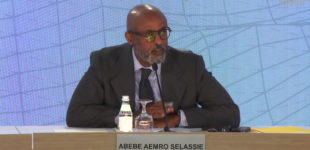

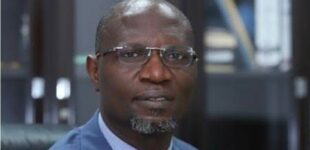
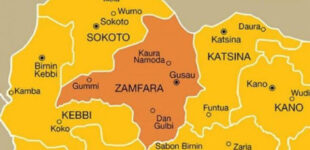

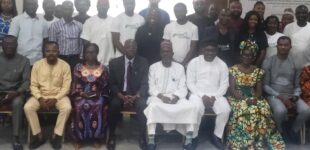


Thank you TheCable
This is excellent and job well done.
You have explicitly described virtually everything associated to the problems faced by people of Ayetoro community.
Meanwhile, it is a blatant lies that the people of the community are demanding for compensation ransom for the siting the project in their community. This is unfounded lie by whoever uttered it which I believe was done to cover up the company’s incompetence, fraudulence,and inability to handle the project.